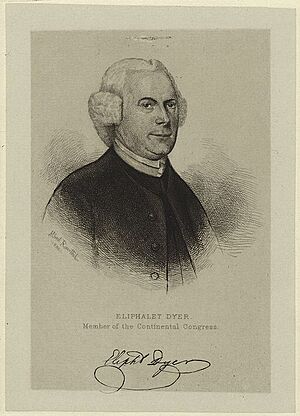Eliphalet Dyer facts for kids
Quick facts for kids
Eliphalet Dyer
|
|
|---|---|
 |
|
| Chief Justice of the Connecticut Supreme Court | |
| In office 1789–1793 |
|
| Delegate to the Continental Congress | |
| In office 1774–1779 |
|
| In office 1782–1783 |
|
| Member of the Connecticut House of Representatives | |
| In office 1756–1784 |
|
| Personal details | |
| Born | September 14, 1721 Windham, Connecticut, U.S. |
| Died | May 13, 1807 (aged 85) Windham, Connecticut, U.S. |
| Resting place | Windham Cemetery |
| Spouse | Huldah |
| Children | 6 |
| Education | Yale College (1740) |
| Military service | |
| Rank | Colonel |
| Battles/wars | French and Indian War |
Eliphalet Dyer (born September 14, 1721 – died May 13, 1807) was an important American leader from Windham, Connecticut. He was a lawyer, a judge, and a politician. He helped lead Connecticut during the time of the American Revolution. He was a representative for Connecticut in the Continental Congress, where he signed an important agreement called the 1774 Continental Association.
Contents
Early Life and Education
Eliphalet Dyer was born in Windham, Connecticut. He went to Yale College and finished his studies in 1740. After that, he studied law and became a lawyer in 1746.
A Career in Public Service
After becoming a lawyer, Dyer joined the local militia, which was like a volunteer army. In 1747, he was chosen to be a justice of the peace. This meant he could handle minor legal cases. He also became a member of the colonial assembly, which was a group that made laws for the colony.
Military Service
During the French and Indian War, Dyer served as a lieutenant colonel in the militia. He helped lead an expedition that captured Crown Point from the French in 1755. He was a Colonel of the Third Connecticut Provincial Regiment. In 1758, he led his regiment to Canada to support other British military leaders.
Role in the American Revolution
In 1763, Dyer traveled to London to try and get land rights for a company. This trip was not successful.
Later, in 1765, Connecticut sent Dyer to New York City for the Stamp Act Congress. This meeting was a protest against new taxes from Britain. It was a very important step leading up to the American Revolution.
In 1766, he became a judge on Connecticut’s superior court. He held this job for many years, becoming the chief judge in 1789. He served as chief judge until 1793.
As the American Revolution began, Dyer was chosen for Connecticut’s Committee of Safety. This group helped protect the state during the war. He was also selected as a representative for Connecticut in the Continental Congress in 1774. He served in the Congress during these periods:
- 1774–1775
- 1777–1779
- 1782–1783
John Adams, another important leader, described Dyer as a bit long-winded in his speeches. But Adams also said Dyer was "an honest, worthy man" who meant well and made good judgments.
Later Life
Eliphalet Dyer stopped working in public service in 1793. He passed away at his home in Windham on May 13, 1807. He is buried in the Windham Cemetery. His daughter, Amelia, married Joseph Trumbull. Joseph Trumbull also served in the Continental Congress with Dyer.

